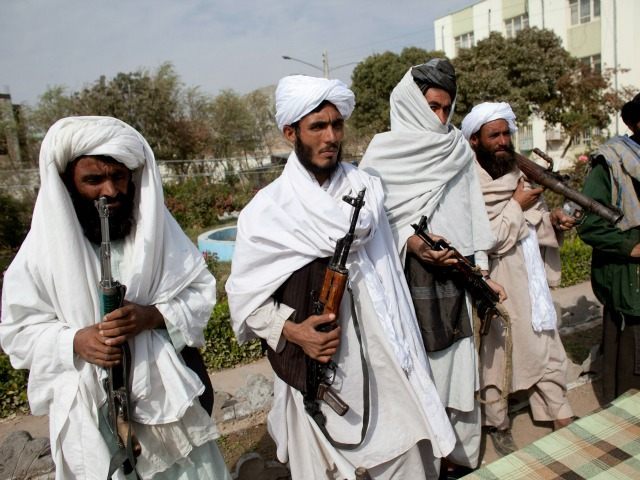Jihadists linked to the Islamic State (ISIS/ISIL) have joined the ranks of the Taliban in Afghanistan, a source at Tajikistan’s State Committee for National Security (SCNS) told the Russian state-owned TASS news agency.
“Naturally, we have taken a number of additional measures, including preventive, to ensure security in the country and on its external borders, especially on the border with Afghanistan,” the anonymous source said, without elaborating further on the details, according to excerpts from the Nov. 14 TASS article provided by BBC Worldwide Monitoring Central Asia Unit.
“Measures have been taken to strengthen the security of external borders. Also, we are very concerned about the approach of Taliban troops to the Tajik border [with Afghanistan],” continued the source, later adding, “Not only Afghan Taliban are fighting in the Taliban ranks, but the entire terrorist international, including groups under the flag of Islamic State (IS, a terrorist group banned in Russia) have also been spotted. Over 700 Tajik citizens are fighting on the side of IS alone.”
Although the source did not provide an exact figure for the number of terrorists allegedly approaching the Tajikistan border from the Afghanistan side, TASS, citing an unnamed “officer” from the Tajik SCNS, reported in October that more than 1,000 gunmen in Afghanistan, mostly from the Taliban, were moving towards the Tajikistan border.
ISIS is allegedly providing support to the Afghan Taliban splinter faction, led by Mullah Mohammad Rasool, that has been clashing with fighters loyal to Mullah Akhtar Mansour who was appointed by the Taliban Supreme Council (Shura Council) to replace the group’s longtime leader Mullah Omar.
The appointment of Mansour did not sit well with some high-ranking Taliban commanders, underlining deep fractures in the group following the 2013 death of founder Mullah Omar, which was finally confirmed in July by the Afghan government and the Taliban.
A number of senior Taliban commanders opposed to Mullah Mansour have reportedly joined the Taliban breakaway group. The appointment of Mullah Rasool to lead the dissident group marks the first official split in the once-unified Taliban.
ISIS has benefited from defections triggered by the infighting among the two rival Taliban factions over the appointment of Mullah Mansour as the group’s new leader.
Mirwais Noorzai, a police chief in Afghanistan’s Zabul province located along the Pakistan border, told Al Jazeera that the Taliban breakaway group was backed by ISIS in a recent fight against militants loyal to Mullah Mansour.
“The Taliban faction under Mullah Rasool was backed by the ISIL and Uzbek fighters in the fight,” said Noorzai.
An estimated 400 ISIS-linked militants from the ethnic Uzbek minority in Afghanistan are fighting alongside Rasool-led dissidents struggling to wrest control of the Taliban away from Mullah Mansour, NBC News reports.
The Islamic Movement of Uzbekistan (IMU) pledged their loyalty to ISIS in a video released July 31.
Abdul Manan Niazi, a spokesperson for the breakaway Taliban faction, denied the claims that the splinter group is associated with ISIS.
“We will never join them. Their ideologies are different; they come from a different background and a different history,” Niazi told Al Jazeera.
“These are all false accusations. We can never ask for their support to fight our enemies or to re-establish Islamic rule,” he added.
Under the leadership of Mullah Mansour, the Taliban has been engaged in turf battles against ISIS fighters in Afghanistan.
Earlier this month, Taliban fighters defeated militants loyal to ISIS, The New York Times reports.
A United Nations report released in September revealed that ISIS is expanding its presence in Afghanistan, actively recruiting followers in nearly three-quarters (25) of the country’s 34 provinces.
According to a top Russian military official, there are an estimated 3,000 ISIS jihadists in Afghanistan.
ISIS has scored military gains in turf battles against the Taliban, securing their hold with brutality that is considered shocking even by the standards of the Afghan insurgency.
Earlier this month, ISIS-linked Uzbek militants in Afghanistan were accused of beheading seven civilians from the country’s Hazara Shiite minority, including two women and a 9-year-old girl.
ISIS officially announced its expansion into the Afghanistan region back in January, on the heels of President Obama’s announcement ending the U.S.-led combat mission as the country was experiencing record levels of violence at the hands of the Taliban.
In September, Russian newspaper Kommersant revealed that Russia may redeploy its military to Tajikistan’s border with Afghanistan in response to the deteriorating security situation facing the Afghan people.
Russia is already helping to strengthen the U.S.-trained Afghan security forces, providing them with weapons and training as they struggled to fend off a strong and aggressive Taliban resurgence.
U.S. Gen. John F. Campbell, the top commander of U.S.-led forces in Afghanistan, warned American lawmakers against Russia filling in the security vacuum that would arise if the U.S. withdraws from Afghanistan.
President Obama has decided to extend the U.S. military presence in Afghanistan beyond 2016, breaking his pledge to withdraw nearly all forces by the end of his presidency in January 2017.

COMMENTS
Please let us know if you're having issues with commenting.